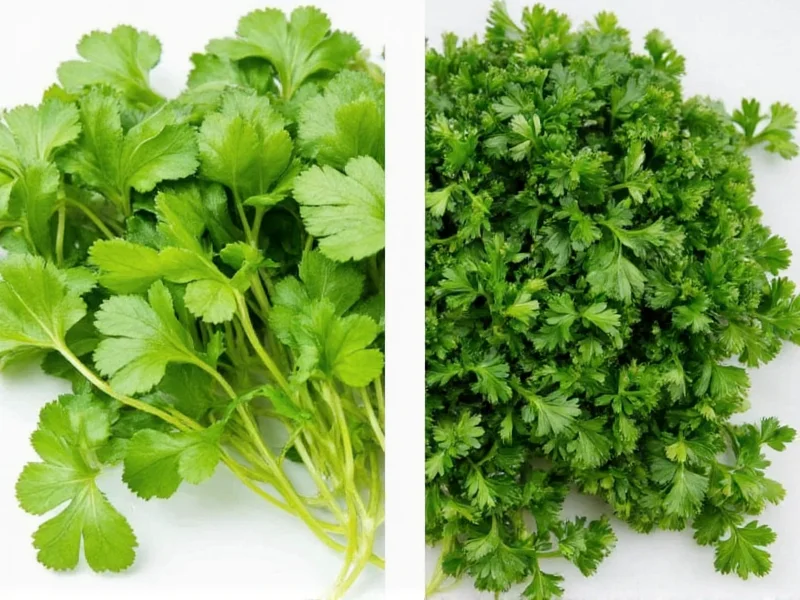Understanding the differences between cilantro and parsley is crucial for home cooks and culinary enthusiasts. Though these herbs appear similar at first glance, their unique characteristics significantly impact flavor profiles and culinary applications. Let's explore the key distinctions that will help you identify, use, and appreciate each herb properly.
Visual Identification: Telling Them Apart
One of the most common challenges is visually distinguishing cilantro from parsley. While both are leafy green herbs, their leaf structures differ significantly:
| Characteristic | Cilantro | Parsley |
|---|---|---|
| Leaf Shape | Rounded, lacy edges with a slightly serrated appearance | Crisp, pointed edges (curly parsley) or flat, serrated leaves (Italian parsley) |
| Stem Structure | More delicate, thinner stems | Sturdier, thicker stems |
| Color | Bright medium green | Darker, richer green |
| Growth Pattern | Leaves grow more horizontally from the stem | Leaves grow more vertically along the stem |
Flavor Profiles and Taste Differences
The cilantro vs parsley taste difference represents their most significant culinary distinction. Cilantro delivers a bold, citrusy flavor with notes of lemon and sage that can be polarizing—approximately 21% of the population carries a gene that makes cilantro taste like soap. This genetic variation explains why some people strongly dislike cilantro while others enjoy its distinctive flavor.
Parsley offers a much milder, grassy flavor with subtle bitter notes. Curly parsley has a slightly more pronounced taste than flat-leaf (Italian) parsley, which is preferred by chefs for its cleaner flavor and easier chopping. When comparing fresh cilantro vs fresh parsley, the intensity difference becomes immediately apparent—cilantro makes a statement in dishes, while parsley blends in more subtly.
Culinary Applications and Best Uses
Understanding when to use each herb elevates your cooking significantly. The culinary uses of cilantro and parsley differ based on their flavor intensity and cultural associations:
- Cilantro: Essential in salsas, guacamole, chutneys, and Southeast Asian curries. Add at the end of cooking to preserve its delicate flavor. Perfect for garnishing tacos, curries, and rice dishes.
- Parsley: Ideal as a finishing herb for soups, stews, and roasted meats. Forms the base of gremolata, chimichurri, and persillade. Curly parsley works well as a garnish, while flat-leaf parsley performs better in cooked dishes.
When considering can I substitute parsley for cilantro, the answer depends on the dish. In most cases, they aren't interchangeable due to their distinct flavor profiles. However, in recipes where appearance matters more than flavor (like garnishes), you might substitute one for the other. For flavor substitution, consider using a combination of parsley and a squeeze of lime to approximate cilantro's citrus notes.
Nutritional Comparison
Both herbs offer impressive nutritional benefits, though with some differences:
- Cilantro: Higher in vitamin K and contains significant amounts of vitamin A and C. Contains antioxidants like quercetin and terpinene that may have anti-inflammatory properties.
- Parsley: Exceptionally high in vitamin K (one tablespoon provides 21% of daily value), vitamin C, and folate. Contains apigenin, a compound studied for potential health benefits.
When examining the nutritional comparison of cilantro and parsley, both contribute valuable nutrients with minimal calories, making them excellent additions to a healthy diet.
Storage and Preservation Tips
Proper storage extends the life of both herbs:
- Cilantro: Store upright in a glass with water (like flowers), loosely covered with a plastic bag in the refrigerator. Replace water every few days. Can be frozen in ice cube trays with water or oil.
- Parsley: Similar storage method works well. Also maintains quality when wrapped in a damp paper towel inside a plastic bag. Dries well for longer-term storage.
Understanding growing cilantro vs parsley can also help if you maintain a kitchen garden. Cilantro grows quickly but bolts (goes to seed) in warm weather, while parsley is more cold-tolerant and perennial in milder climates.
Common Misconceptions
Several myths surround these herbs:
- Misconception: Cilantro and parsley are the same plant at different growth stages.
Reality: They belong to different plant families (Apiaceae for cilantro, Apiaceae for parsley) and are completely distinct species. - Misconception: Coriander and cilantro are different herbs.
Reality: They're the same plant—"cilantro" refers to the leaves/stems, while "coriander" typically refers to the seeds. - Misconception: If you dislike cilantro, you just haven't tried it enough.
Reality: Genetic factors genuinely affect how some people perceive cilantro's flavor, making it objectively unpleasant for them.
Practical Cooking Tips
Maximize your herb usage with these professional tips:
- Always chop herbs with a sharp knife to prevent bruising
- Add cilantro at the end of cooking to preserve its delicate flavor
- Use parsley roots (often discarded) in stocks for additional flavor
- When a recipe calls for "fresh herbs," it typically means parsley unless specified otherwise
- For the best flavor, harvest herbs in the morning when essential oils are most concentrated











 浙公网安备
33010002000092号
浙公网安备
33010002000092号 浙B2-20120091-4
浙B2-20120091-4